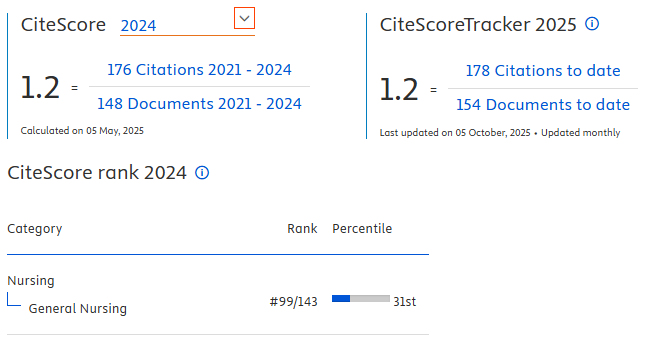The Development of a Six Sigma–Based Ulcus Decubitus Prevention Model to Respond to Adverse Events
Downloads
Introduction: Based on the number of incidences of Ulcus Decubitus in 2015 which was 2.4 "° and 1.59 "° in 2016, the incidences of Ulcus Decubitus is an indicator of patient safety. In one of the public hospitals in Surabaya, it showed that the achievement of a Ulcus Decubitus indicator had not been reached yet (the standard is 1.5 "° per year). One of the efforts that can be done to prevent the occurrence of ulcus decubitus is by way of Six Sigma-based ulcus decubitus prevention.
Methods: The design of this research was an explanatory research study using a cross-sectional approach. The research respondents were nurses at Inpatient Wards (4 Rooms); 57 nurses via the Purposive Sampling technique. The research data was analysed with Partial Least Square (PLS)
Results: Individual factors (Path Coefficient 0,200 t: 6,580), organisational factors (Path Coefficient 0,373 t: 9,278) and management factors (Path Coefficient 0.099 t: 2.184) are all significantly correlated with the Six Sigma-based Ulcus decubitus prevention.
Conclusions: Individual, Organisational and Management factors are important factors in the Six Sigma-based Ulcus Decubitus prevention model. It needs advanced research to find out how much the influence of Six Sigma-based Ulcus Decubitus prevention implementation will decrease the incidences of Ulcus Decubitus.
Adisasmito, W. (2007) Sistem Manajemen Lingkungan Rumah Sakit. Jakarta: Raja Grafindo Persada.
Ammenwertha, Elske; Kutscha, Ulrike; Kutscha, Ansgar; Mahler, Cornelia; Eichstädter, Ronal; Hauxa, R. (2001) ‘Nursing process documentation systems in clinical routine”prerequisites and experiences', International Journal of Medical Informatics, 64, pp. 187–200. doi: https://doi.org/10.1016/S1386-5056 (01) 00216-7.
Ardana, K. (2012) Manajemen Sumber Daya Manusia, Ed 1. Jogyakarta: Graha Ilmu.
Asmuji (2014) Manjemen Keperawatan: Konsep dan Aplikasi,. Jakarta: Ar-Ruzz Media.
Austin, M. (2013) ‘Safety in Numbers: The Development of Leapfrog's Composite Patient Safety Score for U.S. Hospitals. Safety in Numbers.', The Johns Hopkins University School of Medicine, 9, p. 750.
Buchbinder, BS dan Shanks, H. (2014) Buku Ajar Manajemen Pelayanan Kesehatan. Jakarta: EGC.
Chassin, MR, Mayer, C dan Nether, K. (2015) ‘Improving Hand Hygiene at Eight Hospitals in the United States by Targeting Specific Causes of Noncompliance', The Joint Commission Journal on Quality and Patient Safety. Elsevier, 41(1), pp. 4–12. doi: 10.1016/S1553-7250(15)41002-5.
Christoher, SK, David, A, Spahlinger, MD dan John, E. . (2009) ‘Creating Value in Health Care : The Case for Lean Thinking.', JCOM, 16(12).
Cipto (2010) Jaminan Mutu Layanan Kesehatan, Dasar-Dasar Pengertian dan Penerapan. Jakarta: EGC.
Darmawan, D. (2014) Metode Penelitian Kuantitatif. Bandung: Remaja Rosdakarya.
DEPKES RI (2008) Panduan Nasional Keselamatan Pasien Rumah Sakit (Patient Safety). Edited by 2. Jakarta: Bakti Husada.
Furfari, K. (2010) The Lean hospital: What does it mean? The university of Colorado Hospital.
Fursule, NV; Bansod, S. (2012) ‘Understanding the Benefits and Limitations of Six Sigma Methodology.', International Journal of Scientific and Research Publications, 2(1).
Graban, M. (2011) Lean Hospital. Boca Raton: CRC Press.
Haming, M dan Nurnajamuddin, M. (2014) Manajemen Produksi Modern, Operasi Manufaktur Faktor dan Jasa. 3rd edn. Jakarta: Bumi Aksara.
Hasibuan, S. (2014) Manajemen Sumber Daya Manusia,. Jakarta: Bumi Aksara.
Iskandar, H., Maksum, H. and Nafisah, N. (2014) ‘Faktor Penyebab Penurunan Pelaporan Insiden Keselamatan Pasien Rumah Sakit', Jurnal Kedokteran Brawijaya, 28(1), pp. 72–77. doi: 10.21776/ub.jkb.2014.028.01.27.
Jiwanto, A., E. (2015) Standarisasi Proses Layanan Terkait Keselamatan Pasien Melalui Pendekatan Lean Hospital di Rumah Sakit Petrokimia Gresik. Universitas Airlangga.
KARS (2012) Panduan Penyusunan Dokumen Akreditasi, Komisi Akreditasi Rumah Sakit. Jakarta.
Komalawati; Veronica (2010) Community dan Patient Safety Dalam Perspektif Hukum Kesehatan. Jakarta.
Kurniadi, A. (2013) Manajemen Keperawatan dan Prospektifnya, Teori, Konsep dan Aplikasi. Jakarta: Badan Penerbit FKUI.
Laureani, A., Brady, M. and Antony, J. (2013) ‘Applications of Lean Six Sigma in an Irish hospital', Leadership in Health Services, 26(4), pp. 322–337. doi: 10.1108/LHS-01-2012-0002.
Mulyadi (2010) Sistem Perencanaan dan Pengendalian Manajemen. Jakarta: Salemba Empat.
Nenny Puji Lestari, Deni Kurniadi Sunjaya and Avip Syaefullah (2013) ‘Konsep Manajemen Keselamatan Pasien Berbasis Program Di Rsud Kapuas Provinsi Kalimantan Tengah'. Available at: http://repository.unpad.ac.id/18193/ (Accessed: 14 November 2017).
Notoadmodjo (2013) Promosi Kesehatan dan Perilaku Kesehatan. Jakarta: Rineka Cipta.
Wuryanto, E. (2010) Hubungan Lingkungan Kerja dan Karakteristik Individu dengan Kepuasan Kerja Perawat di Rumah Sakit Umum Daerah Tugurejo Semarang. Universitas Indonesia.
Authors who publish with Jurnal Ners agree to the following terms:
- Authors transfer the Copyright and grant Jurnal Ners the right of first publication with the work simultaneously licensed under a Creative Commons Attribution 4.0 International License that allows others to remix, adapt and build upon the work with an acknowledgment of the work's authorship and of the initial publication in Jurnal Ners.
- Authors are permitted to copy and redistribute the journal's published version of the work (e.g., post it to an institutional repository or publish it in a book), with an acknowledgment of its initial publication in Jurnal Ners.
Jurnal Ners requires a formal written declaration and transfer of copyright from the author(s) for each article published. We, therefore, ask you to complete and return this form, retaining a copy for your own records. Your cooperation is essential and appreciated. Any delay will result in a delay in publication. The form can be downloaded HERE.
































